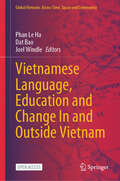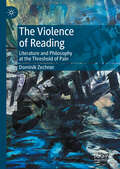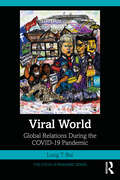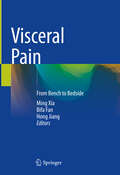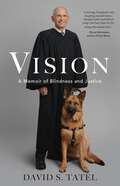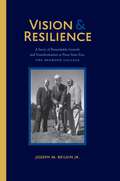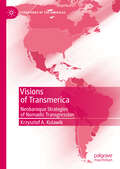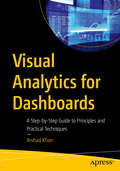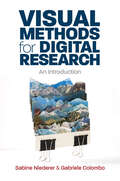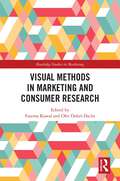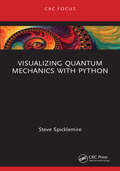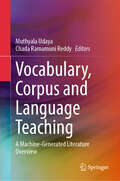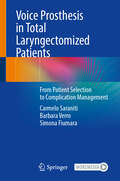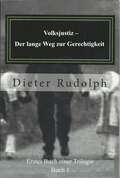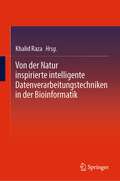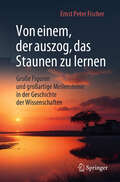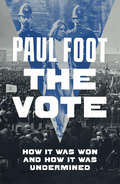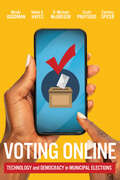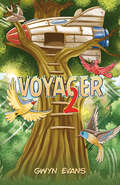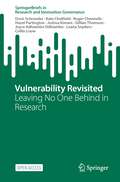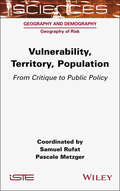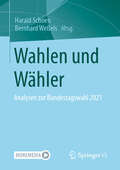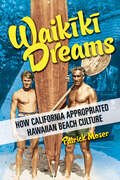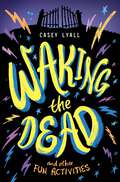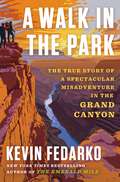- Table View
- List View
Vietnamese Language, Education and Change In and Outside Vietnam (Global Vietnam: Across Time, Space and Community)
by Dat Bao Phan Le Ha Joel WindleThis open access edited book attempts to break new ground in investigating multiple facets of Vietnamese language, education and change in global contexts, engaging with global Vietnam through complex lenses of language and education. Issues of language, globalization, and global identities have often been framed through the lens of hierarchical/binary power relations, and/or through a dichotomy between hyper-central languages, such as English, and revisualized or marginalized local language and cultures. In this book, this dichotomy is turned on its head by considering how Vietnam and Vietnamese are constructed in and outside Vietnam and enacted in global spaces of classrooms, textbooks, student mobility, community engagement, curriculum, and intercultural contacts. Vietnamese is among the world’s most spoken languages and is ranked in the top 20th in terms the number of speakers. Yet, at the same time, as a ‘peripheral’ or ‘southern’ global language as often seen in the Global North-Global South spectrum, the dynamics of multilingual and multicultural encounters involving Vietnamese generate distinctive dilemmas and tensions, as well as pointing to alternative ways of thinking about global phenomena from a fresh angle. Rather than being outside of the global, Vietnamese - like many other ‘non-central’ global languages - is present in diasporas, commercial, and transnational structures of higher education, schooling, and in the more conventional settings of primary and secondary school, in which visions of culture and language also evoke notions of heritage and tradition as well as bring to the fore deep seated ideological conflicts across time, space, communities, and generations. Relevant to students and scholars researching language, education, identity, multiculturalism, and their intersections, particularly related to Vietnam, but also in Southeast Asia and beyond, this volume is a pioneering investigation into overlooked contexts and languages from a global, southern-oriented perspective."This book presents an eclectic collection of 15 chapters unified by an interest in developing and teaching the Vietnamese language. To my knowledge, there has been no previous attempt to make the national language of Vietnam a focus for as many perspectives as are documented in the book. In this regard, the book makes an original and intriguing contribution to the literature on Vietnamese culture, including the culture of Vietnam’s expanding diaspora. The book is pioneering in the extent to which it draws attention to the many roles played by a national language in a nation’s political, social and cultural development. It also documents the challenges of preserving a national language in settings where it is at risk of being marginalized. It is pleasing that so many of the contributing authors are young Vietnamese scholars who can provide a distinctly Vietnamese perspective on concepts and practices of global significance."- Dr. MartinHayden, Emeritus Professor of Higher Education, Southern Cross University, Australia "Vietnamese Language, Education and Change In and Outside Vietnam brings together an excellent collection of chapters that highlight the diverse and important but under-explored roles Vietnamese language plays in different settings within and outside Vietnam. The fifteen chapters of this much needed book provide unique insights into various aspects and meanings of Vietnamese language. Collectively, the volume contributes to broadening our view about the evolution and transformation of Vietnamese language under the impacts of local, national, regional and global forces. The book invites readers to engage in a reflective and intersectional approach to rethinking and re-examining our understandings of the changes and developments of Vietnamese language over the history of the country."- Dr Ly Tran, Professor, Centre for Research for Educational Impact (REDI), Deakin University, Australia, and Founder: Australia-Vietnam
The Violence of Reading: Literature and Philosophy at the Threshold of Pain
by Dominik ZechnerThe Violence of Reading: Literature and Philosophy at the Threshold of Pain expounds the scene of reading as one that produces an overwhelmed body exposed to uncontainable forms of violence. The book argues that the act of reading induces a representational instability that causes the referential function of language to collapse. This breakdown releases a type of “linguistic pain” (Scarry; Butler; Hamacher) that indicates a constitutive wounding of the reading body. The wound of language marks a rupture between linguistic reality and the phenomenal world. Exploring this rupture in various ways, the book brings together texts and genres from diverse traditions and offers close examinations of the rhetoric of masochism (Sacher-Masoch; Deleuze), the relation between reading and abuse (Nietzsche; Proust; Jelinek), the sublime experience of reading (Kant; Kafka; de Man), the “novel of the institution” (Musil; Campe), and literary suicide (Bachmann; Berryman; Okkervil River).
Viral World: Global Relations During the COVID-19 Pandemic (The COVID-19 Pandemic Series)
by Long T. BuiThis book argues that the catastrophe of COVID-19 provided a momentous time for groups, institutions, and states to reassess their worldviews and relationship to the entire world. Following multiple case studies across dozens of countries throughout the course of the pandemic, this book is a timely contribution to cultural knowledge about the pandemic and the viral politics at the heart of it. Mapping the various forms of global consciousness and connectivity engendered by the crisis, the book offers the framework of "viral worlding," defined as viral forms of relationality, becoming, and communication. It demonstrates how worlding or world-making processes accelerated with the novel coronavirus. New emergent forms of being global "went viral" to address conditions of inequality as well as forge possibilities for societal transformation. Considering the tumult wrought by the pandemic, Bui analyzes progressive movements for democracy, abolition, feminism, environmentalism, and socialism against the world-shattering forces of capitalism, authoritarianism, racism, and militarism. Focusing on ways the pandemic disproportionately impacted marginalized communities, particularly in the Global South, this book juxtaposes the closing of their lifeworlds and social worlds by hegemonic global actors with increased collective demands for freedom, mobility, and justice by vulnerable people. The breadth and depth of the book thus provides students, scholars, and general readers with critical insights to understanding the world(s) of COVID-19 and collective efforts to build better new ones.
Visceral Pain: From Bench to Bedside
by Hong Jiang Ming Xia Bifa FanPatients with chronic visceral pain present a challenge for medical providers because of their vague presenting symptoms and frequent lack of identifiable pathology. Despite this, chronic visceral pain can be a debilitating medical condition that increases morbidity and decreases quality of life; the long-term consequences of which cause significant socioeconomic burden and debility. Covering the newest trends, studies, diagnosis and treatments in visceral pain care, as well as the pain treatment strategies that have been successfully employed in the past, this book brings readers fully up to date with effective recognitions and treatments for visceral pain. The clinical evaluation and presentation of common chronic visceral pain conditions and multimodal treatment options that can be used to assist patients and providers are focused.
Vision: A Memoir of Blindness and Justice
by David S. TatelThe "moving, thoughtful, and inspiring memoir" (Bryan Stevenson, author of Just Mercy) by one of America&’s most accomplished public servants and legal thinkers—who spent years denying and working around his blindness, before finally embracing it as an essential part of his identity. David Tatel has served nearly 30 years on America&’s second highest court, the United States Court of Appeals for the D.C. Circuit, where many of our most crucial cases are resolved—or teed up for the Supreme Court. He has championed equal justice for his entire adult life; decided landmark environmental and voting cases; and embodied the ideal of what a great judge should be. Yet he has been blind for the past 50 of his 80-plus years. Initially, he depended upon aides to read texts to him, and more recently, a suite of hi-tech solutions has allowed him to listen to reams of documents at high speeds. At first, he tried to hide his deteriorating vision, and for years, he denied that it had any impact on his career. Only recently, partly thanks to his first-ever guide dog, Vixen, has he come to fully accept his blindness and the role it's played in his personal and professional lives. His story of fighting for justice over many decades, with and without eyesight, is an inspiration to us all.
Vision and Resilience: A Story of Remarkable Growth and Transformation at Penn State Erie, The Behrend College
by Joseph M. Beilein Jr.Vision and Resilience recounts the remarkable turnaround of a satellite campus that became one of the brightest spots in the Penn State University system: Penn State Erie, The Behrend College. Covering the period from 1980 to 2010, this story serves as a blueprint for administrators who aspire to grow their institutions in challenging times.Joseph M. Beilein Jr. writes about how, at a time when tensions were high between faculty and the administration, students and the administration, students and the police, and even among the students themselves, The Behrend College saw an unprecedented increase in enrollment, endowments, land acquisition, building, and curricular opportunities. He describes how administrators John Lilley and Jack Burke worked with local leaders, faculty, and other officials to transform The Behrend College into a research institution—and how they worked with faculty, coaches, and even students to convince young people that Behrend was, in fact, a destination campus. All of these efforts resulted in a college that bucked trends in higher education, demography, and economics to become the leading college in northwestern Pennsylvania.Fascinating and instructive, Vision and Resilience tells an encouraging story of college success against the odds. It will be of interest to university administrators, faculty, and anyone with a personal connection to the Penn State campus farthest from University Park.
Visions of Transmerica: Neobaroque Strategies of Nomadic Transgression (Literatures of the Americas)
by Krzysztof A. KulawikThis book looks at Neobaroque Latin American fiction, poetry, essay and performance from the 1970s to the early 2000s in order to explore the cultural hybridization and transgressive identity transformations at play in these works. It shows how the ornamental style and boldly experimental techniques are an effective strategy in presenting decentered identities in sexually ambiguous, multiethnic, interracial, transcultural, and mutant characters, as well as in metafictional narrators and authors. In this way, the book demonstrates the potential of Neobaroque works to destabilize normative, essentialist and binary categories of identity. The study focuses on Latin America as a cultural macroregion, drawing on examples from a variety of countries, including Argentina, Uruguay, Chile, Bolivia, Brazil, Cuba, Mexico, and the US-Mexican border. Drawing on gender, queer, trans and Chicana feminist theory, it argues for an alternative approach to a model of the Self, or a theory of selfhood, derived from the exuberant style and experimental techniques of the Neobaroque.
Visual Analytics for Dashboards: A Step-by-Step Guide to Principles and Practical Techniques
by Arshad KhanThis book covers the key principles, best practices, and practical techniques for designing and implementing visually compelling dashboards. It explores the various stages of the dashboard development process, from understanding user needs and defining goals, to selecting appropriate visual encodings, designing effective layouts, and employing interactive elements. It also addresses the critical aspect of data storytelling, examining how narratives and context can be woven into dashboards to deliver impactful insights and engage audiences. Visual Analytics for Dashboards is designed to cater to a wide range of readers, from beginners looking to grasp the fundamentals of visual analytics, to seasoned professionals seeking to enhance their dashboard design skills. For different types of readers, such as a data analyst, BI professional, data scientist, or simply someone interested in data visualization, this book aims to equip them with the knowledge and tools necessary to create impactful dashboards. What you’ll learn The principles of data visualization How to create effective dashboards Meet all the requirements for visual analytics/data visualization/dashboard courses Deepen understanding of data presentation and analysis How to use different kinds of tools for data analysis, such as scorecards and key performance indicators Who This Book Is For Business analysts, data analysts, BI professionals, end-users, executives, developers, as well as students in dashboards, data visualizations, and visual analytics courses.
Visual Methods for Digital Research: An Introduction
by Sabine Niederer Gabriele ColomboOver the last decade, images have become a key feature of digital culture; at the same time, they have made a mark on a wide range of research practices.Visual Methods for Digital Research is the first textbook to bring the fields of visual methods and digital research together. Presenting visual methods for digital and participatory research, the book covers both the application of existing digital methods for image research and new visual methodologies developed specifically for digital research. It encompasses various approaches to studying digital images, including the distant reading of image collections, the close reading of visual vernaculars of social media platforms, and participatory research with visual materials. Offering a theoretical framework illustrated with hands-on techniques, Sabine Niederer and Gabriele Colombo provide compelling examples for studying online images through visual and digital means, and discuss critical data practices such as data feminism and digital methods for social and cultural research.This textbook is an accessible and invaluable guide for students and researchers of digital humanities, social sciences, information and communication design, critical data visualization and digital visual culture.
Visual Methods in Marketing and Consumer Research (Routledge Studies in Marketing)
by Fatema KawafDespite the rising popularity of visual research methods, from images and collages to videos and animations, there is an imminent need for a book that can be a point of reference for learning about visual methods in the field of marketing and consumer research. This book offers a comprehensive outlook of visual research methods in the field, highlighting their value and offering a practical guide for researchers. Building on the experiences and discussions of both experienced and aspiring visual researchers, the editors present this book as a ‘go‑to’ guide for doing visual research in marketing and consumer research.This book encompasses nine chapters guiding the readers through the ABCs of visual research from philosophy to data collection and analysis, with a dedicated chapter on research dissemination. You can expect detailed discussions on the ontological and epistemological stance of visual research as well as an elaborate yet simple to follow guide of all aspects of data collection for various forms of visuals, be it static images, memes, collages, videos, animations and so on.The purpose of this book is not only to highlight the value of visual methods in consumer research but also to move this work on and offer a ‘go-to hands-on guide’ for novice visual researchers and PhD candidates who wish to conduct rigorous visual research. It will be a valuable resource not only for those particularly across marketing disciplines, including consumer research and behaviour, but also for visual researchers in fields such as sociology and anthropology.
Visualizing Quantum Mechanics with Python
by Steve SpicklemireQuantum Mechanics can be an abstract and complex subject. Students often complain of confusion, struggle, and frustration as they try to master the topic. The goal of this book is to reduce the complexity and clarify the abstractions with concrete visual examples driven by simple python programs. It is assumed that the reader is concurrently taking a course in quantum mechanics, or self-studying quantum mechanics, but is looking for supplementary material to help with understanding and visualizing how quantum mechanics works.The focus of this book is writing python programs to visualize the underlying behavior of the mathematical theory. The background needed to understand quantum mechanics is differential equations, linear algebra and modern physics. We need a strong foundation in differential equations and linear algebra because the behavior of quantum systems is governed by equations that are written in terms of these concepts. Modern physics includes concepts such as special relativity and quantum phenomena like the photoelectric effect and energy quantization that the theory of quantum mechanics seeks to explain. This book is also not an introduction to the python programming language, or to numpy, or even to VPython. However its programming examples start simply and grow more complex as the chapters progress, so deep expertise in any of these is not a pre-requisite.Key features:· Provides an accessible and practical guide to the abstractions in quantum mechanics with concrete visual examples driven by simple python programs.· Contains few derivations, equations, and proofs.· For complete beginners of python programming, appendix B serves as a very brief introduction to the main concepts needed to understand the code in this book.Dr. Stephen Spicklemire is Associate Professor of Physics at the University of Indianapolis, USA. He has been teaching physics at the University of Indianapolis for more than 30 years. From the implementation of "flipped" physics class to the modernization of scientific computing and laboratory instrumentation courses, he has brought the strengths of his background in physics, engineering and computer science into the classroom. Dr. Spicklemire also does IT and engineering consulting. He is an active participant in several national research initiatives relating to improving physics education. These range from improving materials to help students prepare for class, to supporting students success through standards based grading. He is an active developer of the VPython and WebVPython projects and a contributor to the Matter and Interactions textbook.
Vocabulary, Corpus and Language Teaching: A Machine-Generated Literature Overview
by Muthyala Udaya Chada Ramamuni ReddyThis book is the result of a collaboration between a human editor and an artificial intelligence algorithm to create a machine-generated literature overview of research articles analyzing the importance of ESL/EFL vocabulary and corpus studies. It is a new publication format in which state-of-the-art computer algorithms are applied to select the most relevant articles published in Springer Nature journals and create machine-generated literature reviews by arranging the selected articles in a topical order and creating short summaries of these articles.This comprehensive book explores ESL/EFL vocabulary and corpus studies from five main perspectives: acquisition, strategies, ICT, corpus, and current practices. The sections delve into topics such as the impact of technology on learning, the power of corpora in language education, and innovative vocabulary-development techniques.This book is an essential resource for researchers, educators, and language facilitators seeking a deeper understanding of vocabulary within ESL/EFL teaching and learning contexts.
Voice Prosthesis in Total Laryngectomized Patients: From Patient Selection to Complication Management
by Carmelo Saraniti Barbara Verro Simona FiumaraThe volume offers a comprehensive overview of voice rehabilitation after total laryngectomy through a multidisciplinary approach which is the result of the collaboration between otolaryngology specialists and speech therapists. After a short introduction on total laryngectomy and voice recovery, the volume discusses patient selection for voice prosthesis. The following part describes the surgical steps for prosthesis implantation and replacement, the complications that may occur and their solutions. The fourth part focuses on voice rehabilitation. The closing part reviews the different types of voice prostheses and devices and their use and correct management for optimal respiratory, olfactory and speech rehabilitation. Each topic addressed is supported by a wealth of detailed images and step-by-step videos. Given its features, the volume will be an invaluable tool for ENT specialists and speech therapists as well as residents in these fields.
Volksjustiz - Der lange Weg zur Gerechtigkeit (Book one of a Trilogy #1)
by Dieter RudolphDie fortlaufende Geschichte eines Mörders, der weiterhin die Welt von Menschen befreien will, die als unerwünscht gelten, weil sie Sünden begangen haben, die nicht vergeben werden sollten; sein Ziel sind verurteilte Pädophile! Nach Ansicht unseres Mörders sind einige Jahre im Gefängnis, oft im offenen Vollzug - was manche als luxuriöses Leben bezeichnen - keine ausreichende Strafe. Er plant die Morde genau so, dass die Justiz keinen Anhaltspunkt und kaum Ideen hat, wie die Mordserie beendet werden kann. Und diesem Ziel räumt sie absolute Priorität ein. Der Fall ist für die Polizei in doppelter Hinsicht frustrierend, da der Mörder von der Bevölkerung als Richter der Menschheit gefeiert wird. Die Liste der Kandidaten, denen "Volksjustiz" widerfahren soll, scheint endlos zu sein.
Von der Natur inspirierte intelligente Datenverarbeitungstechniken in der Bioinformatik
by Khalid RazaDieses Buch umfasst und beschäftigt sich mit den jüngsten Fortschritten und modernsten Anwendungen von naturinspirierten Computertechniken (NIC) im Bereich der Bioinformatik und der Computerbiologie, die die medizinischen Wissenschaften bei verschiedenen klinischen Anwendungen unterstützen können. Dieser Sammelband befasst sich mit den grundlegenden Anwendungen, dem Umfang und den Zukunftsperspektiven von NIC-Techniken in der Bioinformatik, einschließlich der Erstellung von Genomprofilen, der Klassifizierung von Genexpressionsdaten, der DNA-Berechnung, der System- und Netzwerkbiologie, der Lösung von Komplikationen bei personalisierten Therapien, der antimikrobiellen Resistenz bei bakteriellen Krankheitserregern und der computergestützten Entwicklung von Arzneimitteln, deren Entdeckung und Therapie. Darüber hinaus wird die Rolle von NIC-Techniken bei verschiedenen Krankheiten und Störungen behandelt, einschließlich Krebserkennung und -diagnose, Brustkrebs, Erkennung von Lungenkrankheiten, Krankheits-Biomarkern und Identifizierung potenzieller Therapeutika.
Von einem, der auszog, das Staunen zu lernen: Große Figuren und großartige Meilensteine in der Geschichte der Wissenschaften
by Ernst Peter Fischer„Wer sich nicht mehr wundern und nicht mehr staunen kann, der ist sozusagen tot und sein Auge erloschen“, hat Albert Einstein einmal geschrieben, und diese Worte haben einen Knaben ermutigt, sich in die Welt der Wissenschaft zu begeben, um hier das Staunen zu lernen. Er wollte und will mit den Wundern der Wissenschaft leben, die den Menschen das Dasein erleichtert und ihr Weltbild ausschmückt. Aus seinem Leben wird hier erzählt und wie er sich in diese faszinierende Sphäre des Geistes hineinträumt. Dabei entsteht ein Roman der Naturwissenschaften, der von den Überraschungen im Innersten der Dinge handelt, die dort zu erleben sind und sich auf die Bedingungen der menschlichen Existenz auswirken. Der Roman stellt in persönlichen Begegnungen und Gesprächen Akteure auf dem Feld der Forschung vor, die nicht nur den Atomen, sondern zum Beispiel auch dem Geheimnis des Lebens und dem Erwachen der Intelligenz auf die Spur gekommen sind und heute versuchen, Maschinen damit auszustatten. Man versteht die Gegenwart besser, wenn man die historischen Erfolge der Wissenschaften kennt, die den modernen Alltag mit digitalen Medien dominieren und auf Fragen zum Klimawandel und zur Energieversorgung antworten können. In diesem Buch kann man beginnen, das zum Verstehen führende Staunen zu lernen, mit dem die Menschheit ihren eingangs von Einstein befürchteten Tod vermeiden und die Welt erleben kann.Ernst Peter Fischer beleuchtet spannend und unterhaltsam die Geschichte der Naturwissenschaft und ihrer Akteure.
The Vote: How It Was Won and How It Was Undermined
by Paul FootThe dramatic story of the peoples' fight for the right to vote in BritainThe culmination of a lifetime's work by the great journalist and historian Paul Foot, The Vote tells the thrilling story of the hard, long-fought struggle for the right to vote in Britain, and the slow erosion that followed.In the tradition of "history from below," Paul Foot examines the great democratic debates that dominated the fight for electoral democracy. Taking readers from the smoke-filled church of the Putney debates, to the dramatic arguments between Thomas Paine and Edmund Burke in the aftermath of the French Revolution, to the rise of Chartism and the struggles for votes for women.Throughout, Foot shows how vested interested first delayed and then hobbled the progress of parliamentary democracy. Concentrating on the vital role played by direct action, he shows how rank-and-file resistance to ruling-class injustice was followed by retreat into parliamentary impotence. Into the twentieth-century, Foot exposes the gaps between the promises of a succession of Labour governments and their actions once in power, and its abandonment of any aspiration to economic democracy.A gripping work of narrative history, written in Paul Foot's inimitable energy and engaged style, this book is a classic work of history, and a must-read for anyone interested in how today's political scene was formed.
Voting Online: Technology and Democracy in Municipal Elections (McGill-Queen's Studies in Urban Governance)
by Zachary Spicer Scott Pruysers Nicole Goodman R. Michael McGregor Helen A. HayesIn an attempt to reverse declining rates of voter participation, governments around the world are turning to electronic voting to improve the efficiency of vote counts, and increase the accessibility and equity of the voting process for electors who may face additional barriers. The Covid-19 pandemic has intensified this trend.Voting Online focuses on Canada, where the technology has been widely embraced by municipal governments with one of the highest rates of use in the world. In the age of cyber elections, Canada is the only country where governments offer fully remote electronic elections and where traditional paper voting is eliminated for entire electorates. Municipalities are the laboratories of electoral modernization when it comes to digital voting reform. We know conspicuously little about the effects of these changes, particularly the elimination of paper ballots.Relying on surveys of voters, non-voters, and candidates in twenty Ontario cities, and a survey of administrators across the province of Ontario, Voting Online provides a holistic view of electronic elections unavailable anywhere else.
Voyager 2
by Gwyn EvansJoin Tod the squirrel and his woodland friends on an exciting adventure as they build their very own spaceship-shaped treehouse! With the help of their new neighbours, the weasel brothers Sammy and Jimmy, they paint their creation in vibrant red, blue, and silver. But the fun doesn't stop there – a wise old raven named Zander takes the friends on thrilling flights through the sky. Filled with laughter, friendship, and colourful illustrations, Voyager 2 is a delightful tale that will spark the imagination of young readers as they follow these lovable characters on their quest to build the treehouse of their dreams.
Vulnerability Revisited: Leaving No One Behind in Research (SpringerBriefs in Research and Innovation Governance)
by Doris Schroeder Roger Chennells Kate Chatfield Hazel Partington Joshua Kimani Gillian Thomson Joyce Adhiambo Odhiambo Leana Snyders Collin LouwOpen access. This open-access book discusses vulnerability and the protection-inclusion dilemma of including those who suffer from serious poverty, severe stigma, and structural violence in research. Co-written with representatives from indigenous peoples in South Africa and sex workers in Nairobi, the authors come down firmly on the side of inclusion. In the spirit of leaving no one behind in research, the team experimented with data collection methods that prioritize research participant needs over researcher needs. This involved foregoing the collection of personal data and community researchers being involved in all stages of the research. In the process, the term ‘vulnerability’ was illuminated across significant language barriers as it was defined by indigenous peoples and sex workers themselves. The book describes a potential alternative to exclusion from research that moves away from traditional research methods. By ensuring that the research is led by vulnerable groups for vulnerable groups, it offers an approach that fosters trust and collaboration with benefits for the community researchers, the wider community as well as research academics. Those living in low-income settings, in dire situations that are summarized with the term ‘vulnerability’ know best what their problems are and which priorities they have. To exclude them from research for their own protection is a patronizing approach which insinuates that researchers and research ethics committees know best. The team from this book have shown that minimally risky and minimally burdensome research tailored towards the needs of highly marginalized and stigmatized communities can be scientifically valuable as well as inclusive and equitable. I congratulate them. Prof. Klaus Leisinger, President Global Values Alliance, Former personal advisor to Kofi Annan on corporate responsibility
Vulnerability, Territory, Population: From Critique to Public Policy
by Samuel Rufat Pascale MetzgerDuring the Covid-19 pandemic, the term "vulnerable" was applied to "individuals" and to "populations", "groups" and "countries" in discussions, laws and regulations; now it applies to all objects in relation to all kinds of threats. However, rather than a label for governing people and places, the notion of "vulnerability" was expected to become an instrument to tackle the root causes of disasters, poverty and maldevelopment, as well as the inequalities and injustices they bring, whether social, political, economic or environmental. Despite this radical dimension, vulnerability has gradually been incorporated into public policies and international recommendations for global risk and disaster management. This book is intended for researchers, students, managers and decision makers concerned with the management of not only risks and crises but also climate and environmental change. The first part examines the multiple theoretical and conceptual approaches; the second explores vulnerability assessments, using examples from the Global North and Global South; and the third discusses tools, public policies and actions taken to reduce vulnerability.
Wahlen und Wähler: Analysen zur Bundestagswahl 2021
by Harald Schoen Bernhard WeßelsDer Band bündelt Analysen führender Wahlforscherinnen und Wahlforscher sowie Politikwissenschaftlerinnen und Politikwissenschaftler aus Deutschland zur Bundestagswahl 2021. Der Band ist die Fortsetzung der sogenannten „Blauen Bände“, die seit ihrem Beginn 1980 umfassend und systematisch Analysen zu allen Bundestagswahlen und zu international relevanten Ergebnissen der Wahlforschung zusammenfasst.
Waikiki Dreams: How California Appropriated Hawaiian Beach Culture (Sport and Society)
by Patrick MoserDespite a genuine admiration for Native Hawaiian culture, white Californians of the 1930s ignored authentic relationships with Native Hawaiians. Surfing became a central part of what emerged instead: a beach culture of dressing, dancing, and acting like an Indigenous people whites idealized. Patrick Moser uses surfing to open a door on the cultural appropriation practiced by Depression-era Californians against a backdrop of settler colonialism and white nationalism. Recreating the imagined leisure and romance of life in Waikīkī attracted people buffeted by economic crisis and dislocation. California-manufactured objects like surfboards became a physical manifestation of a dream that, for all its charms, emerged from a white impulse to both remove and replace Indigenous peoples. Moser traces the rise of beach culture through the lives of trendsetters Tom Blake, John “Doc” Ball, Preston “Pete” Peterson, Mary Ann Hawkins, and Lorrin “Whitey” Harrison while also delving into California’s control over images of Native Hawaiians via movies, tourism, and the surfboard industry. Compelling and innovative, Waikīkī Dreams opens up the origins of a defining California subculture.
Waking the Dead and Other Fun Activities
by Casey LyallSometimes it’s hard to rest in peace. A young trainee witch, a family power gone haywire, a dearly departed grandma, an undead boy, and an evil witch—that’s a recipe for the perfect summer vacation. Both hilarious and heartfelt, this fast-paced mystery about life and death (and afterlife) is for fans of Spirit Hunters and The Miscalculations of Lightning Girl.Twelve-year-old Kimmy Jones wants to excel at the unique (and secret) aspect of her family’s funeral home business. Under the watchful eye of Grandma Bev, Kimmy learns how to raise the recently deceased, request their last wish, and break the connection to send them on. But when Grandma unexpectedly dies herself, Kimmy can’t reach her spirit, and nothing seems like it’s ever going to be right again.Then a boy dies under mysterious circumstances on the night of a meteor shower. With no witnesses, Kimmy’s the only one who can get answers about what happened. So she breaks into the hospital morgue, and for the first time in months, her power works. She Wakes the boy up. Except then Kimmy can’t break the connection and so he stays Awake. Even worse, the boy has no memory of what happened to him. As Kimmy works to unravel the mystery, she discovers secrets about her heritage and learns about a witch who has been wreaking havoc for centuries.Casey Lyall’s supernatural mystery is heartfelt, thrilling, and hilarious. Waking the Dead and Other Fun Activities is perfect for fans of Avi’s School of the Dead and Suzanne Young’s What Stays Buried.
A Walk in the Park: The True Story of a Spectacular Misadventure in the Grand Canyon
by Kevin FedarkoTwo friends, zero preparation, one dream. From the author of the beloved bestseller The Emerald Mile, a rollicking and poignant account of the epic misadventure of a 750-mile odyssey, on foot, through the heart of America&’s most magnificent national park and the grandest wilderness on earth.A few years after quitting his job to follow an ill-advised dream of becoming a guide on the Colorado River, Kevin Fedarko was approached by his best friend, the National Geographic photographer Pete McBride, with a vision as bold as it was harebrained. Together, they would embark on an end-to-end traverse of the Grand Canyon, a journey that, McBride promised, would be &“a walk in the park.&” Against his better judgment, Fedarko agreed to the scheme, unaware that the small cluster of experts who had completed the crossing billed it as &“the toughest hike in the world.&” The ensuing ordeal, which lasted more than a year, revealed a place that was deeper, richer, and far more complex than anything the two men had imagined—and came within a hair&’s breadth of killing them both. They struggled to make their way through the all but impenetrable reaches of its truest wilderness, a vertical labyrinth of thousand-foot cliffs and crumbling ledges where water is measured out by the teaspoon and every step is fraught with peril—and where, even today, there is still no trail along the length of the country&’s best-known and most iconic park. Along the way, veteran long-distance hikers ushered them into secret pockets, invisible to the millions of tourists gathered on the rim, where only a handful of humans have ever laid eyes. Members of the canyon&’s eleven Native American tribes brought them face-to-face with layers of history that forced them to reconsider myths at the center of our national parks—and exposed them to the impinging threats of commercial tourism. Even Fedarko&’s dying father, who had first pointed him toward the canyon more than forty years earlier but had never set foot there himself, opened him to a new way of seeing the landscape. And always, there was the great gorge itself: austere and unforgiving but suffused with magic, drenched in wonder, and redeemed by its own transcendent beauty. A Walk in the Park is a singular portrait of a sublime place, and a deeply moving plea for the preservation of America&’s greatest natural treasure.
